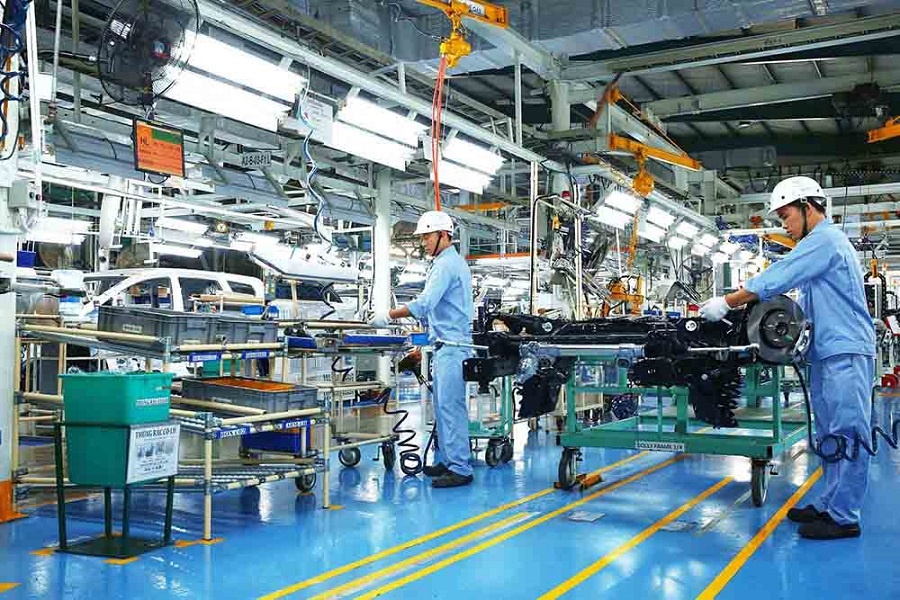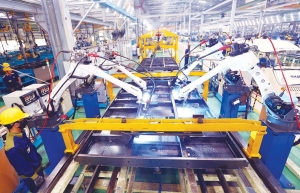Subdued demand dampens manufacturing outlook
 |
The S&P Global Vietnam Manufacturing Purchasing Managers' Index (PMI) slipped from 47.4 in November to 46.4 in December to mark the second consecutive softening of operating conditions across the Vietnamese manufacturing sector. The latest moderation was the strongest since the pandemic-related downturn seen in August 2021.
Reflecting the softer inflows of new work, manufacturers scaled back production volumes in the year's final month. Furthermore, the rate of contraction was rapid and the strongest since September 2021, with the decline in output surpassing the decline in new orders. As a result, backlogs of work increased, ending a four-month period of depletion.
With muted customer demand and new orders, manufacturers started to cut their staffing levels. Employment softened rapidly, posting the sharpest decrease in 14 months.
At the same time, manufacturers also trimmed input buying. However, stockpiles of purchases began to amass for the first time in three months as output plummeted so drastically that inputs were frequently held in stock rather than being employed in the manufacturing process.
Input costs rose at the quickest pace in five months. Manufacturers have to pay higher costs for raw materials, gas and shipping. Meanwhile, suppliers' delivery times have lengthened on a monthly basis.
There were some signs that inflationary pressures were resuming, but the most recent increase in input prices was still far lower than those observed earlier in the year, allowing businesses to decrease charges to consumers to win more new orders.
Some manufacturers expressed fear that difficult market circumstances would continue through 2023. However, many manufacturers expressed hope that demand would increase, which would increase new orders and output.
Andrew Harker, economics director at S&P Global Market Intelligence said, “The Vietnamese manufacturing sector continued to struggle in December, partly due to subdued demand conditions in the key export markets of Mainland China, the EU and US. Securing new work is likely to remain difficult until there is a pick-up in these markets, with several firms indicating that they expect demand to remain subdued in the near-term at least."
"Manufacturers have responded quickly to the downturn in new orders, with the latest PMI data showing sharper reductions in output, employment and purchasing activity, as well as price cuts to try and stimulate demand. S&P Global Market Intelligence is predicting a rise of 6.8 per cent in industrial production for 2023, representing a slowdown from 2022," Harker said.
 | The new face of manufacturing supporting industries Improving Vietnam’s localisation rate, particularly in the country’s supporting industries, is a long-term goal that requires the right policies and incentives as local manufacturing expert Le Lam outlines. |
 | Manufacturing soy milk utilising Aseptic technology The aseptic cold extraction technology is regarded as a significant aspect in establishing and enhancing the value of Number 1's Soya Canxi soy milk and attracting Vietnamese customers. |
 | Viatris inks partnership with Medochemie to boost manufacturing in Vietnam Viatris Inc., a global healthcare company, announced on December 16 that it is broadening its partnership with Medochemie, a Cyprus-based pharma company, to manufacture its innovative products in Vietnam and improve patient access to high-quality locally manufactured medicines. |
What the stars mean:
★ Poor ★ ★ Promising ★★★ Good ★★★★ Very good ★★★★★ Exceptional
 Tag:
Tag:
Related Contents
Latest News
More News
- Ho Chi Minh City hits $8.37 billion in FDI (December 29, 2025 | 08:28)
- Tax sector wraps up 2025 and sets priorities for next year (December 25, 2025 | 14:00)
- Heavy industries set for pilot greenhouse gas quotas (December 25, 2025 | 10:00)
- $250 million deal targets women-owned SMEs, sustainable agriculture (December 22, 2025 | 17:40)
- UOB sees Vietnam growth easing in fourth quarter (December 22, 2025 | 17:39)
- Government moves to establish International Financial Centre (December 21, 2025 | 21:00)
- Vietnam's IFC to target global investment flows (December 21, 2025 | 18:00)
- Ha Tinh breaks ground on major Vingroup industrial and energy projects (December 19, 2025 | 18:24)
- EVN launches major power infrastructure projects nationwide (December 19, 2025 | 18:17)
- VAL inaugurates second production line to meet domestic animal feed demand (December 19, 2025 | 16:37)























 Mobile Version
Mobile Version